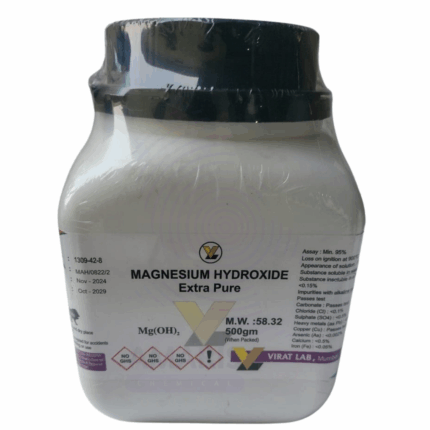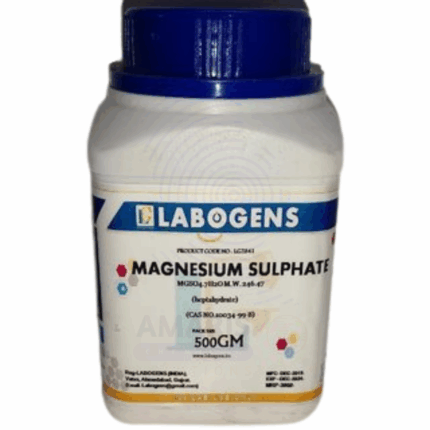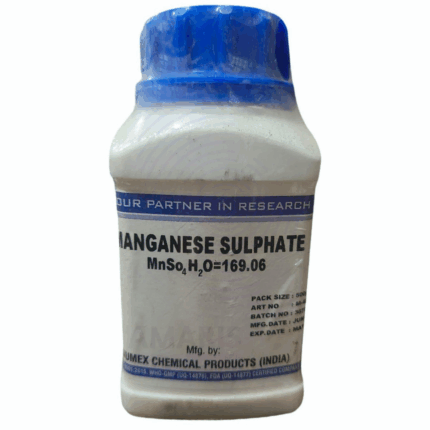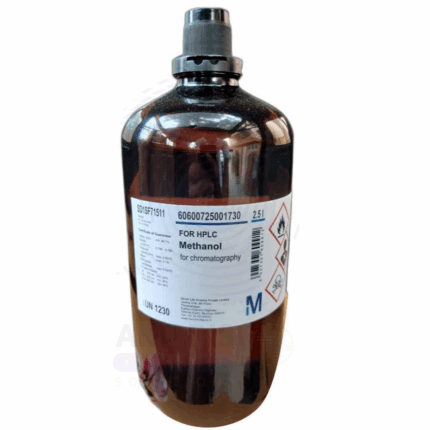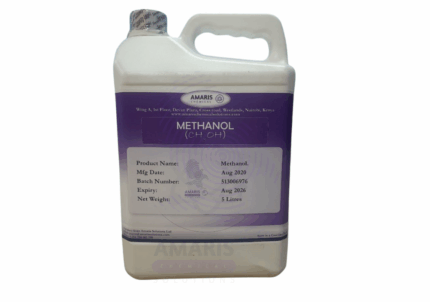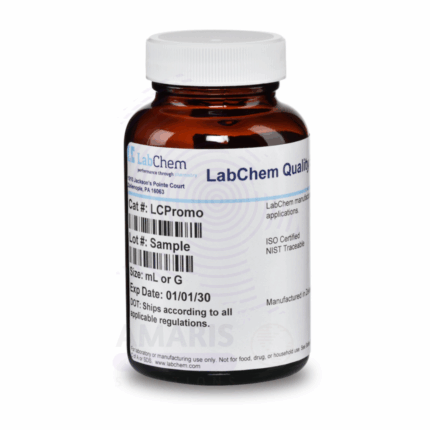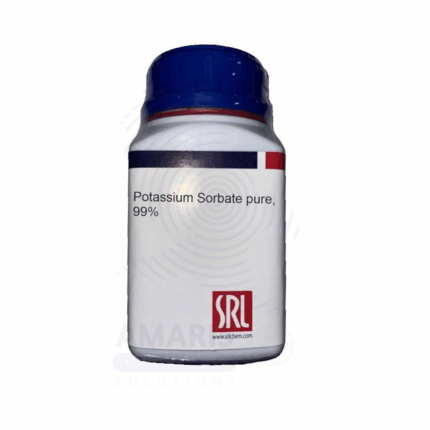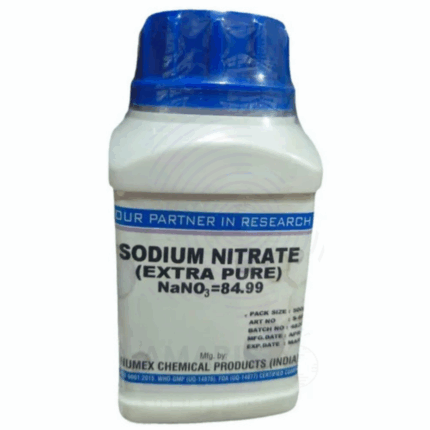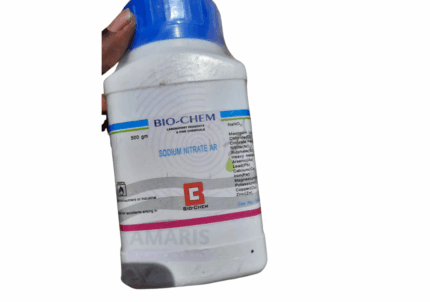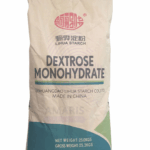
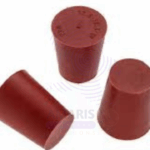
Methyl Paraben Extra Pure
$ 17.85 Original price was: $ 17.85.$ 17.78Current price is: $ 17.78.
Methyl Paraben Extra Pure is a high-purity chemical widely used as a preservative in pharmaceuticals, cosmetics, personal care products, and food applications. It is valued for its strong antimicrobial and antifungal properties, helping to extend the shelf life of various formulations by preventing the growth of bacteria and mold. In laboratories, it is commonly employed in microbiological media and analytical standards. Its excellent stability across a broad pH range, combined with low toxicity and high efficacy even at low concentrations, makes it a preferred choice in sensitive applications. This extra pure grade ensures consistent quality and performance for critical uses.
Methyl Paraben Extra Pure
Primary Uses
- Preservative in Pharmaceuticals – Commonly used to prevent microbial growth in liquid, semi-solid, and solid drug formulations.
- Cosmetic Preservative – Widely employed in lotions, creams, shampoos, and makeup to extend shelf life by inhibiting bacteria and fungi.
Secondary Uses
- Food Additive (when of food-grade) – Occasionally used as a preservative in food products, though regulated in many countries.
- Analytical Standard – Used in laboratories for HPLC analysis and quality control testing of preservatives.
- Personal Care Formulation Testing – Evaluated in research labs for stability and efficacy in new product development.
| PACK SIZE |
500 grams Plastic Tin |
|---|
1. Basic Identification Attributes
- Chemical Name: Methyl Paraben
- IUPAC Name: Methyl 4-hydroxybenzoate
- CAS Number: 99-76-3
- Molecular Formula: C₈H₈O₃
- Molecular Weight: 152.15 g/mol
- Appearance: White crystalline powder
- Odor: Faint, characteristic odor
- Solubility: Slightly soluble in water; freely soluble in alcohol and ether
- Grade: Extra Pure
- Melting Point: 125–128 °C
2. Safety & Hazard Attributes
- GHS Classification: Not classified as hazardous under normal laboratory use
- Hazard Statements:
- May cause mild skin and eye irritation
- Precautionary Statements:
- P280: Wear protective gloves and safety glasses
- P264: Wash hands thoroughly after handling
- P305+P351+P338: IF IN EYES: Rinse cautiously with water for several minutes
- Personal Protective Equipment (PPE):
- Lab coat
- Gloves
- Safety goggles
- First Aid Measures:
- Inhalation: Move to fresh air
- Skin Contact: Wash thoroughly with soap and water
- Eye Contact: Flush eyes with plenty of water
- Ingestion: Rinse mouth and seek medical attention if symptoms develop
- Fire Hazards:
- Flammability: May be combustible at high temperatures
- Extinguishing Media: Dry chemical, foam, CO₂, or water spray
3. Storage & Handling Attributes
- Storage Conditions:
- Store in tightly sealed container
- Keep in cool, dry, and well-ventilated place
- Protect from moisture and light
- Handling Tips:
- Minimize dust generation
- Use in fume hood if fine dust is present
4. Laboratory Applications
- Primary Uses:
- Preservative in pharmaceutical and cosmetic formulations
- Reference material in quality control and analytical chemistry
- Secondary Uses:
- Antifungal and antibacterial agent in lab media
- Research in organic synthesis and stability studies
SAFETY PRECAUTIONS
Personal Protective Equipment (PPE):
- Wear a lab coat, nitrile gloves, and safety goggles.
- Use a dust mask or work in a fume hood if dust is generated.
Handling:
- Avoid contact with skin, eyes, and clothing.
- Prevent formation of dust and avoid inhalation.
- Wash hands thoroughly after handling.
Storage:
- Store in a cool, dry, and well-ventilated area.
- Keep the container tightly sealed and protected from light and moisture.
- Keep away from oxidizing agents.
FIRST AID MEASURES
Inhalation:
- Move to fresh air immediately.
- Seek medical attention if symptoms persist.
Skin Contact:
- Wash with soap and plenty of water.
- Remove contaminated clothing.
- Seek medical attention if irritation develops.
Eye Contact:
- Rinse thoroughly with plenty of water for several minutes.
- Remove contact lenses if present and easy to do.
- Seek medical advice if irritation continues.
Ingestion:
- Rinse mouth with water.
- Do not induce vomiting.
- Seek medical assistance if discomfort occurs.
FIRE FIGHTING MEASURES
Flammability:
- Combustible at high temperatures.
Extinguishing Media:
- Use dry chemicals, CO₂, foam, or water spray.
Hazardous Combustion Products:
- May emit carbon monoxide and carbon dioxide upon decomposition.
Firefighter Protection:
- Wear self-contained breathing apparatus (SCBA) and full protective gear.


 Preservatives(food)
Preservatives(food) Flavor Enhancers
Flavor Enhancers Acidulants
Acidulants Sweeteners
Sweeteners Antioxidants
Antioxidants Colorants(food)
Colorants(food) Nutraceutical Ingredients (food)
Nutraceutical Ingredients (food) Nutrient Supplements
Nutrient Supplements Emulsifiers
Emulsifiers
 Collectors
Collectors Dust Suppressants
Dust Suppressants Explosives and Blasting Agents
Explosives and Blasting Agents Flocculants and Coagulants
Flocculants and Coagulants Frothers
Frothers Leaching Agents
Leaching Agents pH Modifiers
pH Modifiers Precious Metal Extraction Agents
Precious Metal Extraction Agents
 Antioxidants(plastic)
Antioxidants(plastic) Colorants (Pigments, Dyes)
Colorants (Pigments, Dyes) Fillers and Reinforcements
Fillers and Reinforcements Flame Retardants
Flame Retardants Monomers
Monomers Plasticizers
Plasticizers Polymerization Initiators
Polymerization Initiators Stabilizers (UV, Heat)
Stabilizers (UV, Heat)
 Antifoaming Agents
Antifoaming Agents Chelating Agents
Chelating Agents Coagulants and Flocculants
Coagulants and Flocculants Corrosion Inhibitors
Corrosion Inhibitors Disinfectants and Biocides
Disinfectants and Biocides Oxidizing Agents
Oxidizing Agents pH Adjusters
pH Adjusters Scale Inhibitors( water)
Scale Inhibitors( water)
 Antioxidants(cosmetic)
Antioxidants(cosmetic) Emollients
Emollients Fragrances and Essential Oils
Fragrances and Essential Oils Humectants
Humectants Preservatives
Preservatives Surfactants(cosmetic)
Surfactants(cosmetic) Thickeners
Thickeners UV Filters
UV Filters
 Fertilizers
Fertilizers Soil Conditioners
Soil Conditioners Plant Growth Regulators
Plant Growth Regulators Animal Feed Additives
Animal Feed Additives Biostimulants
Biostimulants Pesticides (Herbicides, Insecticides, Fungicides)
Pesticides (Herbicides, Insecticides, Fungicides)
 Active Pharmaceutical Ingredients (APIs)
Active Pharmaceutical Ingredients (APIs) Excipients
Excipients Solvents(pharmaceutical)
Solvents(pharmaceutical) Antibiotics
Antibiotics Antiseptics and Disinfectants
Antiseptics and Disinfectants Vaccine Adjuvants
Vaccine Adjuvants Nutraceutical Ingredients (pharmaceutical)
Nutraceutical Ingredients (pharmaceutical) Analgesics & Antipyretics
Analgesics & Antipyretics
 Analytical Reagents
Analytical Reagents Solvents(lab)
Solvents(lab) Chromatography Chemicals
Chromatography Chemicals Spectroscopy Reagents
Spectroscopy Reagents microbiology-and-cell-culture-reagents
microbiology-and-cell-culture-reagents Molecular Biology Reagents
Molecular Biology Reagents Biochemical Reagents
Biochemical Reagents Inorganic and Organic Standards
Inorganic and Organic Standards Laboratory Safety Chemicals
Laboratory Safety Chemicals Specialty Laboratory Chemicals(Special Laboratory Equipment)
Specialty Laboratory Chemicals(Special Laboratory Equipment)
 Demulsifiers
Demulsifiers Hydraulic Fracturing Fluids
Hydraulic Fracturing Fluids Scale Inhibitors(oil)
Scale Inhibitors(oil) Surfactants(oil)
Surfactants(oil) Drilling Fluids
Drilling Fluids
 Dyes and Pigments
Dyes and Pigments Bleaching Agents
Bleaching Agents Softening Agents
Softening Agents Finishing Agents
Finishing Agents Antistatic Agents
Antistatic Agents
 Admixtures
Admixtures Waterproofing Agents
Waterproofing Agents Sealants and Adhesives
Sealants and Adhesives Curing Compounds
Curing Compounds Concrete Repair Chemicals
Concrete Repair Chemicals Anti-Corrosion Coatings
Anti-Corrosion Coatings
 Surfactants(cleaning)
Surfactants(cleaning) Builders
Builders Enzymes
Enzymes Solvents (Cleaning)
Solvents (Cleaning) Fragrances
Fragrances
 Electronic Chemicals
Electronic Chemicals Catalysts
Catalysts Lubricants
Lubricants Photographic Chemicals
Photographic Chemicals Refrigerants
Refrigerants Automotive chemicals
Automotive chemicals Pyrotechnic Chemicals
Pyrotechnic Chemicals
 Biodegradable Surfactants
Biodegradable Surfactants Bio-based Solvents
Bio-based Solvents Renewable Polymers
Renewable Polymers Carbon Capture Chemicals
Carbon Capture Chemicals Wastewater Treatment Chemicals
Wastewater Treatment Chemicals
 Pigments
Pigments Solvents(paint)
Solvents(paint) Specialty Coatings
Specialty Coatings Binders/Resins
Binders/Resins Additives
Additives Driers
Driers Anti-Corrosion Agents
Anti-Corrosion Agents Functional Coatings
Functional Coatings Application-Specific Coatings
Application-Specific Coatings
 Fresh Herbs
Fresh Herbs Ground Spices
Ground Spices Whole Spices
Whole Spices Spice Blends
Spice Blends Dried Herbs
Dried Herbs
 Leavening Agents
Leavening Agents Dough Conditioners
Dough Conditioners Flour Treatments
Flour Treatments Fat Replacers
Fat Replacers Decoratives
Decoratives Preservatives(baking)
Preservatives(baking)
 Plasticizers & Softeners
Plasticizers & Softeners Reinforcing Agents
Reinforcing Agents Adhesion Promoters
Adhesion Promoters Vulcanizing Agents
Vulcanizing Agents Antidegradants
Antidegradants Blowing Agents
Blowing Agents Fillers & Extenders
Fillers & Extenders Accelerators & Retarders
Accelerators & Retarders


